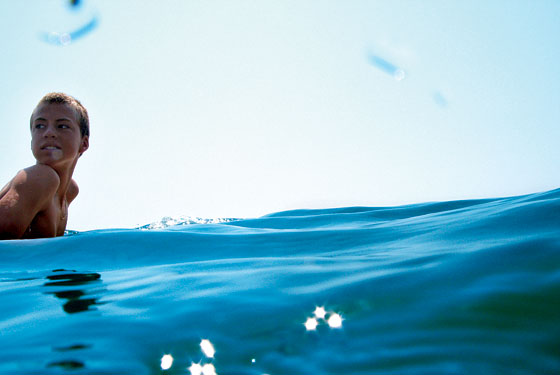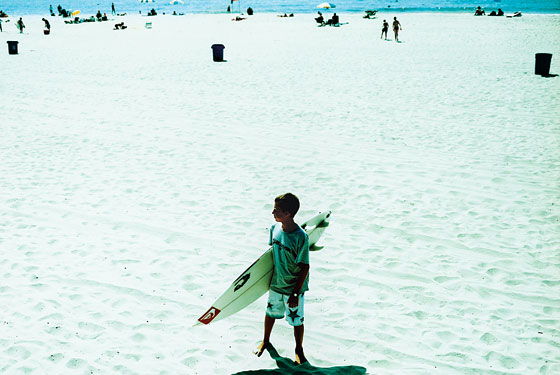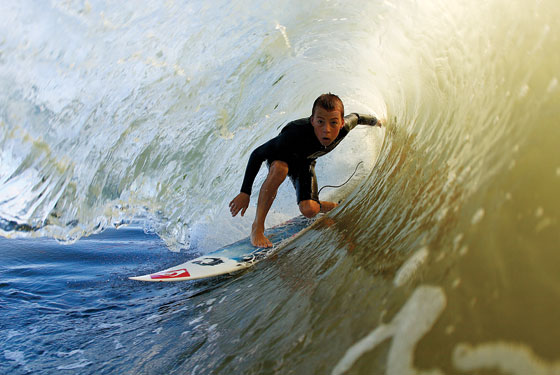
Just a mile east of the Queens County line and less than an hour down the L.I.E. from Manhattan is Long Beach: a surf community of sorts, albeit one overwhelmed by high-rises and the constant roar of JFK air traffic. The ocean at the end of Laurelton Boulevard resembles Lake Erie more than the Atlantic that once served up the Perfect Storm.
“Pretty weak out there,” says Balaram Stack. “But we’re supposed to be getting a little wave tomorrow.”
Fifteen-year-old Balaram Stack is poised to be the single greatest surfer ever to come out of the tri-state area. A couple dozen trophies grace his mantelpiece, at least six sponsors have their hooks in him, and his quintessential surfer-boy face appears, larger than life, in Quiksilver’s flagship Times Square store.
As far as surfing goes, New York is about as far from the epicenter as one can get. It’s torturously inconsistent in summer, dangerously cold in winter, and void of any kind of high-caliber wave energy. But in the insular world of surfing, Stack’s a hero. And considering there hasn’t been a New York champ since the seventies, and that urban surfers get no respect in the beach-centric surf culture, it’s no wonder he’s become a local favorite—he’s the city surfer’s chance to prove the boys from California wrong.
Apart from the dream wave airbrushed on the brick façade, there’s very little to distinguish Long Beach’s Unsound Surf Shop from the outlet stores, Dunkin’ Donuts, and pizza joints that surround it. But inside, it’s Southern California. On a waveless day in August, a gaggle of sun-kissed teenagers in low-slung shorts and baseball caps gather around a TV set and stare unblinkingly as a sprightly Hawaiian on a red board goes up-down, up-down, up-down, across a perfect wave on a remote Indonesian break. It’s “Young Guns 2”—one of the many new videos that feature up-to-the-minute high-performance surfing footage. There’s no plot, just wave after wave of big moves and deep tubes cut to whiny punk rock. And it’s precisely this type of video that’s triggered a kind of globalization within the surf culture. The same way yak-riding Tibetans quote Tupac, young surfers from uncharted locales ape world champions like Kelly Slater, Andy Irons, and C.J. Hobgood. Their own champion, Balaram, is due back from the Lost Pro Junior tournament in Huntington Beach any second now.
Fifteen minutes earlier, the Unsound posse grabbed a little towhead with a pink nose, dragged him out to the parking lot, taped his hands and feet together, covered his eyes with surf stickers, tied him to a board rack, and left him to bake in the 95-degree sun. It’s less a specific cruelty than a surf-shop hazing ritual. Anything to while away the midsummer flatness.
Stack enters the shop in shorts and T-shirt and with skateboard under arm. He’s just returned from Huntington Beach.
“How’d it go?” asks one of the kids.
“Not good. Lost by point-one in the round of 96.”
The kids express condolences. They’re visibly bummed.
“This next wave’s sick,” says Stack in reference to the video, a way to deflect attention.
One thing you learn real quick about Stack is that he’s not comfortable talking about himself. He’ll morph into Superman the moment he hits the water, but on land he’s a sheepish Clark Kent. Part of it’s being 15, part of it’s adhering to the Surfer’s Code, which champions actions over words. It’s easy to take him for just another local skate rat. His buddies call him “Ball-sac” and rib him constantly. Had he arrived twenty minutes earlier, it might well have been him tied to that board rack. Unsound co-owner Mike Nelson has been watching Stack since the boy was 10, and says that Stack is almost oblivious to his own talent.
“He’ll go up against guys he sees in the videos with this awe, thinking they’re at a higher level than he is. But what he doesn’t realize is he’s one of ’em. And a lot of the time, he’s even better than they are.”
After staring at the video for a few minutes, Stack takes his skateboard and escapes to the parking lot in order to ride through a tunnel of overgrown foliage. There’s something unmistakably surflike in the way he bends his knees, cocks his arms as if drawing bow and arrow, and tickles the leaves with his fingertips. He may be riding a skateboard through a row of bushes, but in his mind, he’s getting tubed at Pipeline, G-Land, Cloudbreak. Somewhere far from Long Island.

Before he could even walk, Balaram was crawling around in the Florida shorebreak not far from where he was born, trying to keep pace with his two older brothers, who are both avid surfers. A few years later, he graduated to a boogie board. On the day his single mom moved the family to New York, when he was 5, his brothers took him out on a surfboard, thinking it would mark the end of their balmy beach life. But the Long Beach cold didn’t deter Balaram, and he was so adept at standing rather than lying on his boogie board that his brothers soon felt obliged to get him a real surfboard.
“He was a natural,” says Nelson. “Most kids have to be taught, but Balaram just sort of understood the wave. It was this strange, innate sense.”
When he was 12, his mother entered him in Long Beach’s annual King of the Beach contest. Even before Stack’s third wave, the officials concluded he had won and he was called out of the water. That afternoon, they sent him back out in the superheat—a competition for first place among the winners from each age division.
“He was just doing his little water bug,” remembers his mother, Mary. “His little zip zip, zip zip. The waves were so small he was the only one that could make anything of it.”
They announced the results: Stack had won. But because they couldn’t pronounce his name, they called him Bottle Rocket—so began a new nickname.
“We took him to Burger King to celebrate. And you know how they have those paper gold crowns? We got one, put it on his head, and that was it,” Mary says.
A couple of months later, he entered a regional competition, the Volcom Jellyfish tournament, and though he placed second, it led to a spot on the Unsound team and the tutelage of Nelson and Unsound co-owner Dave Juan. “We focused on getting him into contests where he’d be surfing against the nation’s best,” says Nelson.
That winter, Stack surfed almost every day before and after school, sometimes trekking over snow to reach the water, sometimes wearing two wetsuits on top of each other to beat the sub-40-degree water temperatures. On weekends he was competing in the Eastern Surfing Association, an amateur league, and doing well. All the training and competition paid off when Quiksilver rolled through Long Island in the summer of ’04 to host a one-day surf camp. Stack signed up, paddled out, surfed for a couple of hours, and by the time he came in, he had a new sponsor. Quiksilver sent him to Hawaii that winter to train with rest of the team. There he confronted what’s potentially an East Coaster’s Achilles heel: big waves.
The North Shore, where he stayed, is the mecca of professional surfing. And although Stack was humbled by waves three times his size, he returned with a newfound glint in his eye. At school he wrote essays about becoming a pro surfer when he grew up. Stack’s mom, recognizing determination, started actively working toward realizing her son’s dream. For the last two years she’s spent most weekends driving him to pro-am contests up and down the East Coast. Stack won the Jellyfish two years in a row, the juniors division of the 2006 Unsound Pro, and the ’06 Northeast Regional Surfing Championships. Sponsorship deals followed: Red Bull, Oakley, Sector 9, WRV, Vestal, Freak. Stack’s photo began regularly appearing in surf magazines and the pro-surfing career began to crystallize.
Today, it’s all about flying out to contests across the country, shooting with photographers whenever the waves are good, and spending winter break on Hawaii’s North Shore to work on his big-wave skills. He’s conquered his fear, and though big-wave riding isn’t a strong point in his surfing, he’s improving fast.
Some surfers, drawn to the glory of the double- or triple-overhead, will sit out the small stuff, but not Stack. At home, the small stuff is all he’s got. When the waves are flat, he’ll swim laps at the local pool. When they’re subpar—which is 90 percent of the time—he’ll put in fifteen-minute mock-heats in which he projects himself into make-or-break contest moments, and find ways to make even the smallest wave look powerful. The road to surfing superstardom has come to resemble Olympic figure skating more than the glazed-eyed hedonism of yesteryear, and Balaram Stack is leaving no stone unturned in his ascent.
The following afternoon, the waves come up. Stack pulls into the parking lot at the base of Laurelton with his buddy Richie Bogart. Richie looks too young to be driving his mom’s tan SUV, but he’s actually 19. They go straight for their boards without so much as glancing at the surf. They open the rear gate and pull out backpacks, wetsuits, towels, and tools and spread them around the car as if setting out a picnic. Stack then pulls out a board so spankin’ new it smells of wet resin. A semipro’s earnings are limited—but the boards, wetsuits, and endless gear he gets are free.
“Wearin’ a leash?” he asks Richie. Leashes are a sign of weakness; they’re for people who fall off their boards.
“Nah.”
Stack wraps a towel around his waist and shimmies out of shorts and T-shirt and into a black short-sleeve wetsuit with reddish accents on the shoulders. There’s a transformation. Before, he looked like your average skater kid; now he’s morphed into a five-foot-three action figure and looks as if he could bust into a series of spinning heel kicks or triple somersaults at any second.

They scoop up their gear, toss it into the back of the truck, and jog over the boardwalk, down a ramp, and across the beach. A slight onshore breeze has added a little oomph to the waves, but it’s still a far cry from decent.
Stack stops at the shoreline, swings his torso back and forth, and grinds his feet in the sand to wipe away any grease he may have picked up. At his level of surfing, traction is everything. The more board can become appendage, the better.
He paddles out and catches a wave almost immediately. He flings himself across the waist-high face, as if trying to break free of the water. He sets his sights on a little bend in the lip ten yards down the line, and when he gets to it he boosts up and over, airborne for an epically long moment, then lands atop the wave and continues riding. Finally, he kicks out in a single motion, paddles a few yards, and heads straight into another one.
After he catches six or seven waves in the space of ten minutes, his strengths become obvious. He’s a fishboy. He never fails to be in the right place at the right time. He’s zippy and nimble, his rear foot poised to torque his fins out and skid across the wave whenever the opportunity arises—a signature move, more like a skater’s grind than a surfer’s carve. Like most of the greats who hail from surf-deprived locales, he has the ability to make terrible waves look amazing. And that, ironically, has been his key strength in competitions so far. The dates of surf contests are set months in advance, organizers choose prime locations and pray for swell, but just as often a contest will end up being held in feeble, Long Beach–like waves. In the semipro tour especially, the waves are often pretty meager—exactly the kind of conditions that Stack can exploit better than just about anyone.
On Friday of this week, Stack competes in the Red Bull Night Riders in Atlantic City, where the cream of the East Coast pro circuit will be in attendance. Stack will be one of the youngest, but he’s completely capable of winning it all. It’s a “tow-at” event in which competitors use Jet Ski assistance to fling them into waves, the idea being that the faster you go, the higher you can launch, another of Stack’s specialties. He’s light, he’s preternaturally agile, and he has a lot of big-air experience riding skateboards. To make things interesting, they hold it at night under massive spotlights. Next month he’ll be battling against pros from around the world in the Unsound Pro at Long Beach. With the home-court advantage, the odds stack in his favor.
The last world-class surfer to come out of the Big Apple was Rick Rasmussen in the seventies. He became known first for his bold tube riding at Pipeline, then for getting busted with a kilo of coke in Bali. He was eventually shot dead in the streets of Harlem in a deal gone bad. Since then there have been small flickers but no real contenders. Which is yet another reason why Stack’s success would be so sweet. He’d be the flag-flier for surfers in unlikely places, the little engine that proved that great surfers can come from anywhere, even New York.
The hopes of a new generation of urban surfers are a lot for a 15-year-old boy to shoulder, but Stack bears the weight lightly. What really drives him is his sense of play. The rigors of competition have yet to strip the fun out of it. When he comes unglued, for instance, and has to swim to shore to retrieve his board, he bodysurfs a few waves, as if to prove his act is not confined to just standing. And when he does wash in, he scuttles across the shiny sand, grabs his board, and then rolls back out on the same surge as if riding the ebb and flow of the sea, a giddy child bedazzled by water.